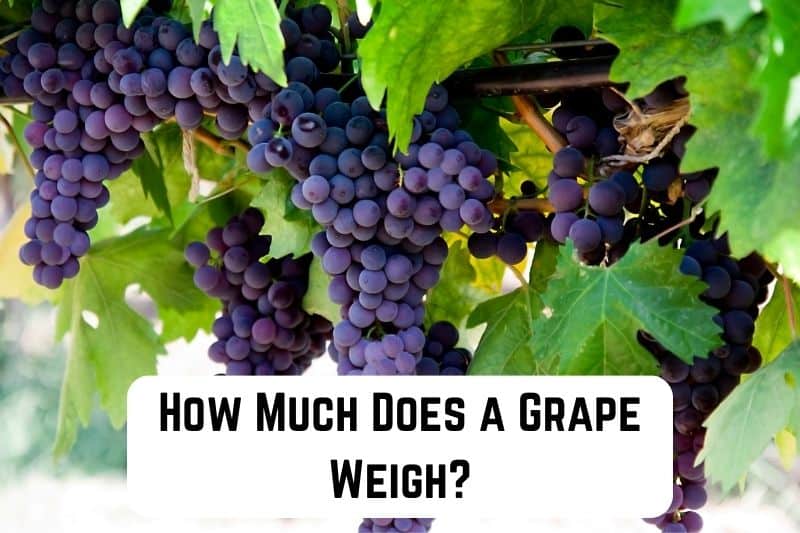Have you ever wondered how much a grape weighs? It might seem like an odd question, but understanding the weight of a grape can help us appreciate the delightful fruit that graces our fruit salads, snack platters, and even a glass of fine wine.
As a curious individual, I have always been intrigued by different fruits and their properties. So, I decided to dive into the fascinating world of grapes and find out how much they weigh. In this article, we will explore the varying weights of different grape varieties and factors that can affect grape weight.
The grape world has various shapes, sizes, and weights, from tiny seedless grapes to large, plump, and juicy ones. Just how much does a single grape weigh, though? Let’s dive into the data and insights gathered on this fruity topic!

Read: How Much Does an Orange Weigh? (Quick Guide)
Table grapes are typically bigger and feature prominently in fruit platters. They weigh about 5-10 grams on average. Wine grapes are mainly used for making wine and are usually smaller than table grapes. These grapes typically weigh between 1.5-3 grams each.
The Anatomy of a Grape
Types of Grapes

I want to mention that there are thousands of grape varieties worldwide, but they can be broadly classified into two categories: table grapes and wine grapes.
As the name suggests, table grapes are most commonly eaten fresh or used in recipes. Wine grapes, on the other hand, are primarily used for winemaking.
Some popular table grape varieties include Thompson Seedless, Flame Seedless, and Concord, while common wine grape varieties are Chardonnay, Merlot, and Cabernet Sauvignon.
Size Variation

Grapes can vary significantly in size depending on the variety and growing conditions. Generally, table grapes are larger and more uniform than wine grapes.
Some grapes may be as small as a pea, while others may reach the size of a small plum. Factors influencing grape size include genetics, vineyard practices, and environmental conditions, such as sunlight, temperature, and water availability.
Average Weight of a Grape
I’ve always found it fascinating how small fruits like grapes can significantly impact our lives. Grapes are delicious and essential for wine, juice, and dried fruits.
I’ve been curious about how much a single grape weighs. Let me share some information on the average weight of a single grape.

First of all, grapes come in different varieties and sizes, which also affects their weight. Common grape types include table grapes and wine grapes. Table grapes are typically bigger and feature prominently in fruit platters. They weigh about 5-10 grams on average.

On the other hand, wine grapes are mainly used for making wine and are usually smaller than table grapes. These grapes typically weigh between 1.5-3 grams each. Since size and weight can vary among grape types, it’s essential to consider these factors when discussing the average weight of a single grape.

As for seedless grapes, these popular snack favorites average around 2-4 grams each. It’s essential to remember that a grape’s weight can also be affected by its maturity and overall health.
Different Types of Grapes
White Grapes

In my experience, white grapes usually weigh between 1.5 and 3 grams each. These grapes are typically found in varieties such as Chardonnay and Pinot Grigio. They can vary in size, but the average diameter of a white grape is around 15 millimeters. Here’s a quick breakdown of their weight:
- Small white grapes: 1.5 – 2 grams
- Medium white grapes: 2 – 2.5 grams
- Large white grapes: 2.5 – 3 grams
Black Grapes

Next, let me discuss black grapes, which include varieties like Cabernet Sauvignon and Merlot. These grapes also have a similar weight range to white grapes, averaging 1.5 to 3 grams per grape. Here’s a handy breakdown:
- Small black grapes: 1.5 – 2 grams
- Medium black grapes: 2 – 2.5 grams
- Large black grapes: 2.5 – 3 grams
Green Grapes

Green grapes, such as the popular Thompson seedless, usually weigh 2 to 4 grams each. Their average diameter can be slightly larger than other grape varieties, ranging from 15 to 20 millimeters. Let’s break down their weight range:
- Small green grapes: 2 – 2.5 grams
- Medium green grapes: 2.5 – 3.5 grams
- Large green grapes: 3.5 – 4 grams
Purple Grapes

Lastly, I want to talk about purple grapes, which include varieties like Concord and Red Globe. Purple grapes have a similar weight range as other grapes, coming in at around 1.5 to 3 grams. Here’s how their weight typically breaks down:
- Small purple grapes: 1.5 – 2 grams
- Medium purple grapes: 2 – 2.5 grams
- Large purple grapes: 2.5 – 3 grams
These are general estimates, and individual grape weight may vary depending on the variety and growing conditions.
Influence of Different Growth Conditions on Grape Weight
Temperature Impact
As a grape enthusiast, I have observed that temperature plays a significant role in grape weight. Grapevines must be grown in the proper temperature range, typically between 50-95°F (10-35°C).
When temperatures are higher, grapes tend to grow bigger and juicier. But on the flip side, if the temperature is too low or too high, it may result in smaller, less-juicy grapes.
Soil Influence
In my experience, soil also has a considerable effect on grape weight. Grapes generally thrive in well-drained, slightly acidic to neutral soils. I’ve noticed that if the soil is too heavy or compact, it can lead to poor root development, thus affecting grape size.
On the other hand, when the soil is enriched with organic matter and nutrients, like potassium and nitrogen, grapes grow bigger, with more flavor and juiciness.
Here are some key soil characteristics that impact grape weight:
- Soil texture
- Drainage
- Nutrient content
- pH levels
Water Necessity
I can’t stress enough the importance of water in grape weight. Inconsistent watering, over-watering, or under-watering can affect grape size and quality. If grapevines receive too little water, the grapes may not develop fully, resulting in smaller, less juicy fruits.
However, receiving too much water may cause the grapes to swell and crack, affecting their size and quality. Proper irrigation techniques, such as drip irrigation, can help ensure the right amount of water is supplied to grapevines.
Effects of Sun Exposure
Lastly, sun exposure is crucial to grape development, quality, and weight. I have observed that grapevines require adequate sunlight for photosynthesis, which is essential for the growth and ripening of grapes.
Grapevines generally need around 6-8 hours of sun a day. If they receive too little sun, the grapes may not ripen fully and will be smaller. On the other hand, too much sun exposure can lead to sunburn and damage, again affecting the size and quality of grapes.
So, in my experience and observation, ensuring proper temperature, soil conditions, water, and sun exposure greatly influences the weight and quality of grapes.
Read: How Much Does a Banana Weigh? (Quick Guide)
Grape Growing Process

Grapes grow on vines and need specific conditions to thrive, such as well-drained soil, ample sunshine, and a temperate climate. The grape-growing process can be divided into several stages:
- Dormancy: In winter, the grapevine’s growth pauses, conserving energy for the following growing season.
- Bud Break: As temperatures warm up in spring, buds on the grapevine begin to swell and eventually break open.
- Flowering: During late spring, the grapevine produces small, fragrant flowers that will eventually become grapes.
- Fruit Set: After pollination, the fertilized flowers drop their petals, and tiny grapes develop.
- Veraison: As the grapes grow and ripen in mid-to-late summer, they change color and accumulate sugar.
Frequently Asked Questions
How many grams do ten grapes typically weigh?
Grape weight can vary based on size. A medium-sized grape typically weighs around 5 grams, so ten grapes would weigh approximately 50 grams. However, weight may vary for larger or smaller grapes.
What is the weight of 1 cup of grapes?
A cup of medium-sized seedless grapes weighs around 150 grams, but the weight could vary depending on the variety or size of grapes used.
How many grapes are in a pound?
A medium-sized grape usually weighs about 5 grams or 0.176 ounces. So, there are roughly 90 to 100 medium-sized grapes in a pound. The number could vary slightly based on the grape’s size and type.
What’s the weight of a grape in ounces?
The weight of a grape varies with its size. A medium-sized grape weighs around 5 grams or 0.176 ounces. Remember, the weight may differ for grapes of varying sizes or types.







